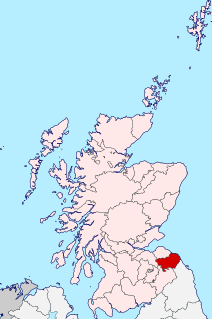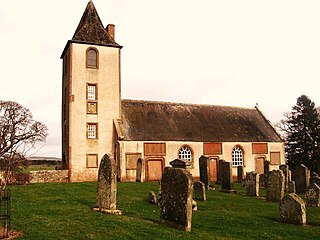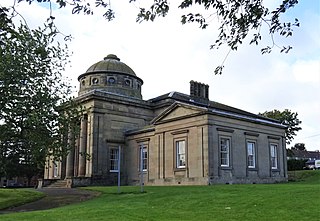
Lady Grizel Baillie, née Hume, was a Scottish gentlewoman and songwriter. Her accounting ledgers, in which she kept details about her household for more than 50 years, provide information about social life in Scotland in the eighteenth century.

Berwickshire is a historic county, registration county and lieutenancy area in southeastern Scotland, on the English border. It takes its name from Berwick-upon-Tweed, which was part of Scotland at the time of the county's formation, but became part of England in 1482 after several centuries of swapping back and forth between the two kingdoms.

Lord Polwarth, of Polwarth in the County of Berwick, is a title in the Peerage of Scotland. It was created in 1690 for Sir Patrick Hume of Polwarth, 2nd Baronet, Lord Chancellor of Scotland from 1696 to 1702. In 1697 he was further created Lord Polwarth, of Polwarth, Redbraes and Greenlaw, Viscount of Blasonberrie and Earl of Marchmont, also in the Peerage of Scotland. Upon the death of his grandson, the third Earl, the creations of 1697 became dormant (unclaimed).

Greenlaw is a town and civil parish situated in the foothills of the Lammermuir Hills on Blackadder Water at the junction of the A697 and the A6105 in the Scottish Borders area of Scotland. At the 2001 census, the parish had a population of 661.
Alexander Hume was a Scottish poet who served as Moderator of the General Assembly of the Church of Scotland in the early 17th century.

Coldingham is a village and parish in Scottish Borders, on Scotland's southeast coastline, north of Eyemouth.

Patrick Hume, 1st Earl of Marchmont, known as Sir Patrick Hume, 2nd Baronet from 1648 to 1690 and as Lord Polwarth from 1690 to 1697, was a Scottish statesman. His grandfather was the poet and courtier Sir Patrick Hume of Polwarth and Redbraes who died in 1609.

Polwarth is a village and parish in the Scottish Borders area of Scotland. It is located at grid reference NT745502, between Greenlaw and Duns, in the former county of Berwickshire.

Marchmont House lies on the east side of the small village of Greenlaw, and near to a church in Polwarth in Berwickshire, in the Scottish Borders area of Scotland. It is about five miles south west of Duns, about 19 miles (31 km) west of Berwick-upon-Tweed and about 40 miles (64 km) south east of Edinburgh. Situated in a gently undulating landscape, the estate is intersected by Blackadder Water, and its tributary burns. With the Lammermuir Hills to the north and views towards the Cheviot Hills in the south, this part of Berwickshire, sometimes referred to as the Merse, is very scenic and contains rich and fertile agricultural land.

Marchmont Estate lies near the village of Greenlaw in Berwickshire in the Scottish Borders area of Scotland, circa 45 miles (72 km) south east of Edinburgh. It is situated in the Merse, an area between the Lammermuirs to the north and the Cheviots to the south. It is part of what is commonly regarded as an exceptionally beautiful landscape, comprising a diverse range of land types from high and exposed grouse moor to rich alluvial agricultural land. The life of the estate has seen many stages, including rapid growth, shrinkage and stability, from its foundation in the fifteenth century under the first Hume owner, Patrick Hume, of Polwarth, through his successors and subsequent owners to the present day.

Greenlaw Town Hall is a municipal building in The Square, Greenlaw, Scottish Borders, Scotland. The structure, which served as the county headquarters of Berwickshire in the 19th century, is a Category A listed building.

Chirnside Parish Church is a kirk of the Church of Scotland. It is situated on the B6355 road between Duns and Eyemouth in the old county of Berwickshire, now part of the Scottish Borders, at grid reference NT869560. The town of Chirnside is 6 miles (9.7 km) east of Duns, and 9 miles (14 km) north-west of Berwick-upon-Tweed.

Gavinton is a small settlement in the Scottish Borders area of Scotland, 2 kilometres (1.2 mi) south-west of Duns, the former county town of Berwickshire. The hamlet sits on a minor road off the A6105 Duns to Greenlaw road at grid reference NT767521.
Fogo is a village in the county of Berwickshire, in the Borders of Scotland, 3 miles south of Duns, on the Blackadder Water.

Preston is a small village in the ancient county of Berwickshire, now an administrative area of the Scottish Borders region of Scotland. It lies within the local Abbey St Bathans, Bonkyl & Preston Community Council area.
Leitholm is a village in the Scottish Borders area of Scotland, 4 miles (6.4 km) north-west of Coldstream, in the former county of Berwickshire.

The Crosshall Cross is a cross at Crosshall Farm, Eccles, in the Scottish Borders area of Scotland, in historic Berwickshire.
Sir Patrick Hume of Polwarth and Redbraes was a Scottish courtier and makar.

Hugh Hume-Campbell, 3rd Earl of Marchmont PC FRS, styled Lord Polwarth between 1724 and 1740, was a Scottish politician who sat in the House of Commons from 1734 until 1740 when he succeeded to the peerage as Earl of Marchmont. He sat in the House of Lords as a representative peer from 1750.
















